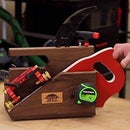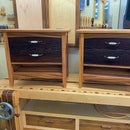Introduction: Floating Picture Frames
Floating picture frames really lend themselves well to canvas art. They're relatively simple to build and can be as fancy as you like.
What follows are a pair of frames that I built for my wife and her cousin after an art class that they attended. There are no "plans" for this build as frame sizes are dependent on the size of the artwork.
There's a full build video that should fill in any gaps that I missed in the write-up.
Step 1: Tools and Materials
Tools
- Table Saw - With dado stack - (can also be done at the router table)
- Jointer
- Planer
- Miter Sled (Optional) See previous Instructable
- Band Clamp
- Random Orbit Sander
- Drill / Screw Driver
Materials
- 4/4 Lumber of choice
- 4/4 Dark lumber of choice
Lumber selections will be discussed in a future step.
Step 2: Material Selection
Material selection plays an important role in ensuring that these frames create the illusion of the canvas floating inside the frame.
The frame itself can be any material desired. However, it's important that the backer portion be a dark material so as to not be readily seen.
I chose Wenge as my backer material although there are certainly less expensive options that would work just as well. Some examples of less expensive materials include painted plywood and dyed hardwood.
Step 3: Milling Lumber
As always in woodworking, it's important to be able to mill lumber flat and square.
For this project, the final thickness isn't important as long as the workpiece is flat and square. My goal is to have material around 3/4" in thickness.
The backer material should be wide enough to account for the depth of the dado, 1/2" gap around the frame, and at least 3/4" of the frame material. My backer material was 1.5" wide.
It's also important to ensure that your parts are long enough for the frame you wish to build. Don't forget to account for the miters as they add extra length to the piece.
Step 4: Cutting the Rabbet
The only thing that should be seen from the side of the frame, is the "show" lumber selected. To accomplish this, there's a shallow rabbet cut inside each edge of the frame material. This Rabbet needs to be cut to accept the material chosen as the backer material.
The rabbet is cut using a 3/4" dado stack in the table saw and a sacrificial fence because my material was slightly shy of 3/4" and the blade needed to be slightly buried in the fence.
Step 5: Gluing Up the Parts
With the parts all cut, glue up the parts ensuring that there are no gaps or voids.
Note: Miters will be done in the next step so, it's only important that the parts are sufficient in length for your frame.
Step 6: The Miters
Cut miters on each piece ensuring that they are 1" longer than the artwork on the inside of the miter. This will allow for 1/2" gap between the artwork and the frame. The measurements for these cuts will depend on the artwork you intend to frame.
Cutting the miters can be the frustrating portion of any picture frame build. A miter gauge at the table saw, miter saw, or even hand cutting the miters will work. I've created a sled for the table saw that I find works really well for these cuts. This video and Instructable documents the sled build.
Step 7: Gluing Up the Frame
Once the pieces are cut properly, I used a Band Clamp to glue up the frame in preparation for the installation of the artwork.
Step 8: Details Before Finish
The final step before the finish is to prep the frame. This includes pilot drilling/countersinking to mount the artwork and any finish sanding that needs to be done. I sanded all parts to 180 grit.
Step 9: The Finish
I started the finish using General Finishes Arm-R-Seal, a wipe on polyurethane. I then followed that up with a few coats of General Finishes High Performance. I block sanded with 400 grit sandpaper between coats.
The sprayed finish is a film finish so add coats until the desired look is achieved.
Step 10: Installing the Artwork - Hardware
I cut some 1/2" spacer blocks to fit around the artwork to ensure that it was evenly spaced in the frame. I then flipped the frame over and pilot drilled into the canvas frame (don't drill all the way through) and inserted screws to attach the artwork. I used wax on the screws to make driving them easier.
There are lots of hanging options available. I prefer a wire hanger as it makes it easier to hang on the wall. Whatever hanging hardware you choose, follow the manufacturer's recommendations for mounting that hardware.
Step 11: Closing
These picture frames are fairly simple to build and lend themselves well to batching out several at the same time. I have had requests from others that take these art classes with my wife to build frames for them.
These can easily be built in a day with the artwork being mounted the following day after the finish is cured. Material costs can be very inexpensive to very expensive but the frames always look great regardless of the lumber choices.

Participated in the
Woodworking Contest













